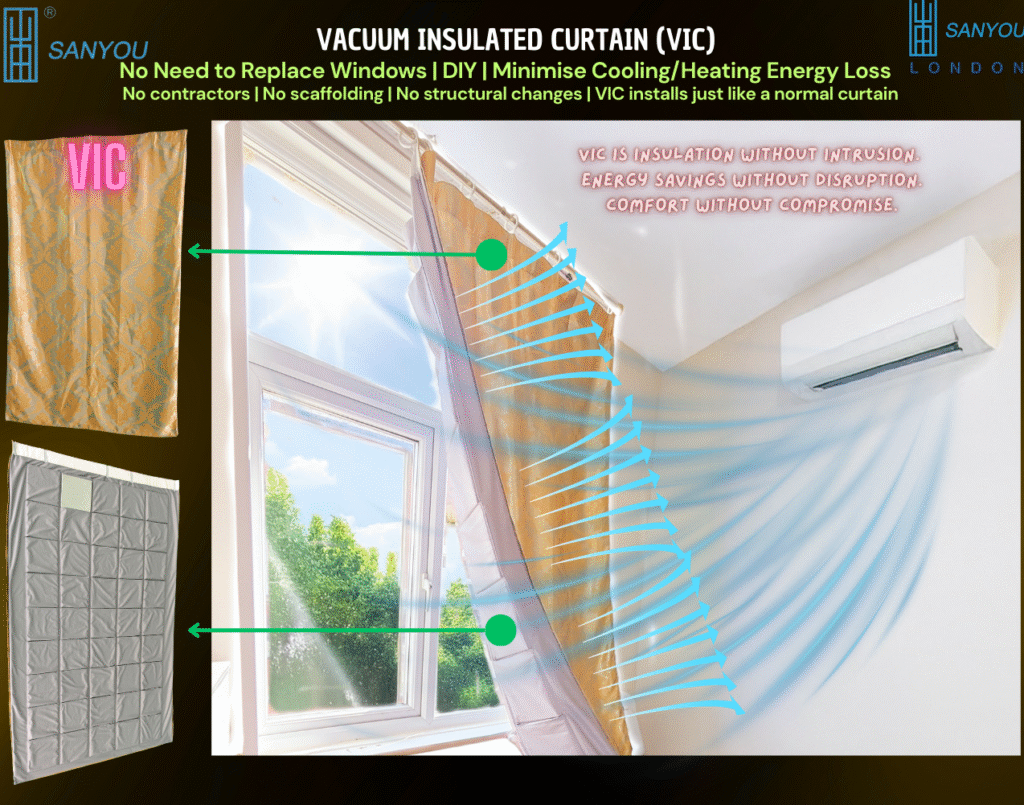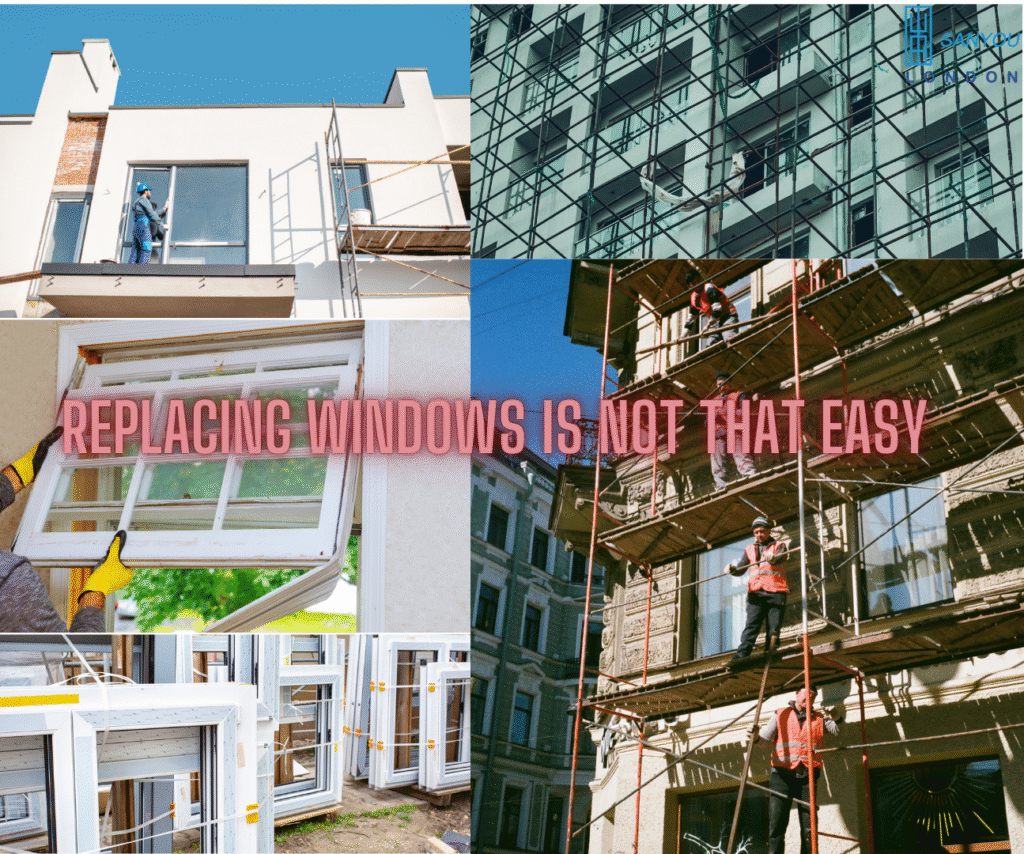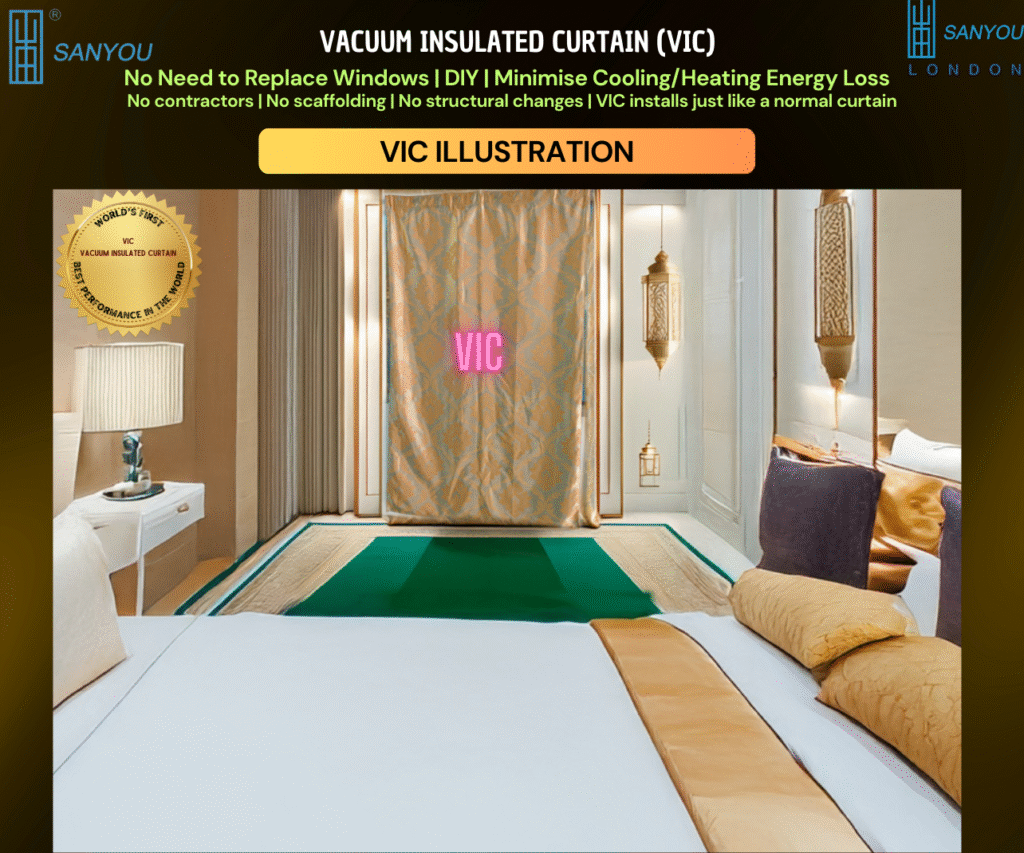
Vacuum Insulated Curtain (VIC): A Disruptive DIY Breakthrough for Real Energy Savings—No Contractors, No Window Replacement, No Compromise
I want to speak plainly. don’t want to waste your time with imaginations; I’d rather talk about problems you actually face and a practical way to solve them without turning your home into a building site.
The short version
You do not need to replace your windows to cut heat loss or cooling loss.
VIC is the world’s first curtain with a built-in vacuum-insulation layer—invented by Professor Saim Memon—that delivers the kind of performance people expect from costly glazing upgrades, without contractors, scaffolding, or planning delays.
- Thermal conductivity (λ): 13.1 mW·m⁻¹·K⁻¹
- U-value (curtain assembly): 1.87 W·m⁻²·K⁻¹
- Performance comparison at the window:
- Up to 8× better than sheer curtains
- ≈4× better than lined curtains
- >2.5× better than most blackout curtains
And if you rent, VIC moves with you. It’s yours, not the landlord’s glazing.

Why window replacement so often stalls

On paper, better windows cut losses. In reality, replacement is expensive, slow, and frequently unrealistic—particularly with listed buildings and conservation areas in the UK, where original single glazing is protected and consent to replace is often refused. Even where it is allowed, quotes can run 3–4× the product cost, with long lead times and disruptive works.
VIC sidesteps all of that. You hang it on a standard pole or track and you are done.
What is VIC, exactly?

VIC is a three-layer curtain system:
- Back layer (cotton): stitched pockets in a 200 × 200 mm grid
- Core: ultra-thin 3 mm vacuum-insulated panels (VIPs) inserted into those pockets
- Front layer (decorative): your choice of satin, silk, or polyester so it looks like a premium curtain
Pocket spacing: 10 mm between units so the curtain folds and glides naturally.
VIPs: removable and replaceable, making service and upgrades simple.
Logistics: modular segments make shipping and storage efficient.
You install exactly like a normal curtain:
- No contractors
- No scaffolding
- No structural alterations
What performance looks like in practice
- Cold climates (UK and Europe): significant reduction in heat loss through single or older double glazing; warmer rooms, fewer draughts, and quicker warm-up after the heating comes on.
- Hot-arid climates (Saudi Arabia, UAE, Qatar, Kuwait): up to 33% cooling-energy savings reported in use cases where large glazed façades dominate and air-conditioning runs long hours. VIC cuts solar and ambient heat ingress when drawn, stabilising internal temperatures.
Transparency note: VIC is still a curtain, not a sealed glazing system. There are edge effects around the sides and at the sill. Even so, the overall gain is substantial for the time and cost involved.
How is VIC different from other “thermal” curtains?
Most thermal or blackout curtains rely on thicker fabrics and foams. VIC is different: the vacuum core slashes heat transfer far beyond what dense textiles can achieve at similar thickness, which is why λ = 13.1 mW·m⁻¹·K⁻¹ and U = 1.87 W·m⁻²·K⁻¹ are in a different league.
Who is VIC for?
- Homeowners who want measurable savings without builders in the house
- Tenants who need portable energy upgrades that do not affect the fabric of the building
- Heritage and conservation projects where glazing cannot legally be replaced
- Developers and housing providers seeking fast, low-disruption improvements across portfolios
- Hotels, schools, offices with large glazed areas and tight maintenance windows
Common questions (and clear answers)
Will it darken my room?
By day, keep VIC open; by night, draw it for performance. Choose lighter decorative fabrics if you prefer brighter rooms when closed.
Does it work with bay windows or wide spans?
Yes. We size panels to standard curtain widths (including fullness). For bays, use curved tracks or segment the span; stack-back and return details matter and we’ll guide you.
What about condensation?
VIC reduces radiant heat loss and surface cooling on the room side, which can help comfort. Ensure rooms are ventilated appropriately—standard good practice.
Is cleaning straightforward?
Yes. The decorative front is chosen for wipe-clean or dry-clean care. The VIPs stay sealed within the rear pockets.
Can I install it myself?
Yes—just like any quality curtain. Use a suitable pole or track with anchors sized for the loaded curtain weight.
Quick installation notes (keep it simple)
- Width: follow your usual fullness (typically 1.8–2.2× pole width)
- Drop: measure sill-to-pole; allow for preferred puddle or off-floor clearance
- Header: eyelet, pencil pleat, double or triple pinch—your choice
- Returns: add side returns to bring the curtain face back to the wall; this reduces edge leakage
- Stack-back: ensure space for full opening so glazing is clear in the day
If you want detailed guidance, ask us for the VIC measuring and installation sheet—we keep it short and practical.
From research to reality
My background is vacuum glazing—designs, edge-seals, and thermal modelling—over 15 years of research and industrial collaboration. Vacuum glazing remains powerful but is costly, fragile, and slow to scale in many real settings. VIC was born from that truth: take the physics of vacuum insulation, package it in a familiar, low-risk format, and make it usable today.

What comes next: VIHC
The Vacuum Insulated Heatable Curtain (VIHC) is our active variant—adding a thin heating mesh behind the 3 mm vacuum layer for zoned radiant warmth in cold climates. VIC is the passive version; VIHC adds comfort heat at very low power. See the VIHC product catalogue for details.
VIC is…
Insulation without intrusion; energy savings without disruption; comfort without compromise.
This invention is the outcome of scientific research, real-world engineering, and a desire to solve practical problems. It is a proud step forward for Sanyou London Pvt Ltd, created in partnership with Jiangsu Sanyou Dior Energy Saving New Materials Co. Ltd, following the success of our Vacuum Insulated Wallpaper (VIW).
Ready to specify—or want to try one room first?
- Contact our Customer Service Team for sizing, fabric choices, lead times, and pricing tailored to your windows.
- Prefer a direct conversation? Speak with Professor Saim Memon by email or phone to discuss your rooms, energy targets, and a quick payback plan.
- Explore VIC specifications, purchasing steps, videos, and FAQs at www.sanyoulondon.com.
If replacing windows feels impossible, VIC gives you a realistic path to lower bills and better comfort—installed in an afternoon, enjoyed for years.
Share

Author
Prof. Dr. Saim Memon
PhD, CEng, FHEA, MSc, BEng(Hons), PGC-TQFE, GTCS, MCMI, MIET, MIEEE, MInstP, IBPSA, APCBEES, MPEC
CEO | Industrial Professor | Inventor | British Scientist | Chartered Engineer | Qualified Teacher | Chief Editor | World Speaker | Pioneer in Vacuum Insulation Energy Technologies

